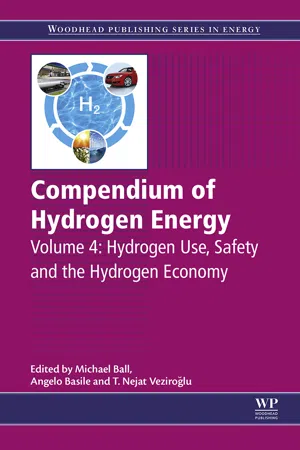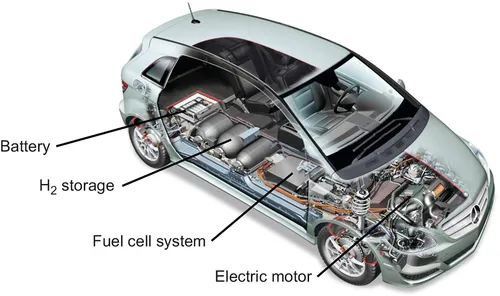
eBook - ePub
Compendium of Hydrogen Energy
Hydrogen Use, Safety and the Hydrogen Economy
This is a test
- 386 pages
- English
- ePUB (mobile friendly)
- Available on iOS & Android
eBook - ePub
Compendium of Hydrogen Energy
Hydrogen Use, Safety and the Hydrogen Economy
Book details
Book preview
Table of contents
Citations
About This Book
Compendium of Hydrogen Energy Volume 4: Hydrogen Use, Safety and the Hydrogen Economy focuses on the uses of hydrogen. As many experts believe the hydrogen economy will, at some point, replace the fossil fuel economy as the primary source of the world's energy, this book investigates the uses of this energy, from transport, to stationary and portable applications, with final sections discussing the difficulties and possibilities of the widespread adoption of the hydrogen economy.
- Written by both leading academics in the fields of sustainable energy and experts from the world of industry
- Part of a very comprehensive compendium which across four volumes looks at the entirety of the hydrogen energy economy
- Covers a wide array of hydrogen uses, and details safety tactics, hydrogen applications in transport, and the hydrogen economy as a whole
Frequently asked questions
At the moment all of our mobile-responsive ePub books are available to download via the app. Most of our PDFs are also available to download and we're working on making the final remaining ones downloadable now. Learn more here.
Both plans give you full access to the library and all of Perlego’s features. The only differences are the price and subscription period: With the annual plan you’ll save around 30% compared to 12 months on the monthly plan.
We are an online textbook subscription service, where you can get access to an entire online library for less than the price of a single book per month. With over 1 million books across 1000+ topics, we’ve got you covered! Learn more here.
Look out for the read-aloud symbol on your next book to see if you can listen to it. The read-aloud tool reads text aloud for you, highlighting the text as it is being read. You can pause it, speed it up and slow it down. Learn more here.
Yes, you can access Compendium of Hydrogen Energy by Michael Ball,Angelo Basile,T. Nejat Veziroglu in PDF and/or ePUB format, as well as other popular books in Technology & Engineering & Renewable Power Resources. We have over one million books available in our catalogue for you to explore.
Information
Part One
Hydrogen applications in transport and industry
1
Hydrogen-fueled road automobiles – Passenger cars and buses
J. Wind Daimler AG, Kirchheim/Teck-Nabern, Germany
Abstract
In this chapter, the main differences/similarities and advantages/disadvantages of hydrogen- fuelled road automobiles are presented, as compared to other drive-train technologies such as internal combustion engines (ICE), hybrid electric vehicles, range extenders, plug-in hybrids and battery electric vehicles. Further, the different hydrogen-fuelled drive systems are explained, namely fuel cell electric vehicles (FCEVs), hybrid FCEVs and hydrogen ICE vehicles. In addition to descriptions of the different drive systems, advantages and disadvantages in terms of efficiency, range, costs and other aspects are discussed. The possible technological solutions to realization of FCEVs are another discussion point. Challenges facing FCEVs, such as the buildup of a hydrogen refuelling infrastructure, cost issues and commercialization efforts, are also described. The chapter closes with consideration of main markets and the possible technological and socioeconomic development.
Keywords
Fuel cell electric vehicle
Electric vehicle
Fuel cell system components
Electric motor
Power electronics
Battery.
1.1 Introduction
In this chapter, the use of hydrogen in road vehicle propulsion is described. Today, all of the main original equipment manufacturers (OEMs) are developing fuel cell electric vehicles (FCEVs) directly fueled with hydrogen. The goal of the most advanced OEMs is to enter the market between 2015 and 2018 (Toyota Motor Corporation, 2015a; Honda AG, 2015a; Daimler AG, 2015a; Thomas Reuters Deutschland GmbH, 2015). Hydrogen internal combustion engine vehicles (H2-ICE) are no longer considered to be a reasonable solution for the future of road mobility (Die Welt, n.d.). Thus, hydrogen-fueled (fuel cell electric) vehicles are pure electrical vehicles (EVs).
Due to the very high efficiency of all drive-train components used in FCEVs, the vehicle’s overall efficiency is about twice the efficiency of a gasoline- or diesel-fueled vehicle with an internal combustion engine (ICE) (Europäische Kommission, 2013). Further, hydrogen-fueled FCEVs emit no polluting components nor any greenhouse gas (GHG). FCEVs, when fueled with hydrogen, are true zero-emission vehicles (ZEVs) and thus have a very high potential to contribute significantly to the reduction of GHGs and energy (fuel) consumption.
Unlike battery electric vehicles (BEVs), which are also pure EVs and ZEVs, FCEVs are suitable for large driving ranges and can be fueled in a few minutes. However, the overall efficiency of BEVs is significantly higher. Vehicles combining ICEs and electric drive trains, such as hybrid electric vehicles (HEV), plug-in hybrid electric vehicles and range extender electric vehicles, also contribute to a reduction of GHG emissions and energy consumption due to increasing efficiency with increase of the electrification rate. However, those drive trains all need fossil fuels for the ICE and emit harmful air polluting components as well as GHG emissions. This chapter focuses on FCEVs for the reasons explained here.
1.2 Comparison of different hydrogen-fueled drive systems
Hydrogen as a fuel for propulsion of road vehicles was considered in the early nineteenth century, when Francois Isaac de Rivaz built the world’s first hydrogen-fueled vehicle in 1807 (Ginlex and Cahen, 2011). It took more than a century for OEMs to take up the idea of using hydrogen as a fuel and develop several prototypes of passenger cars and buses with H2-ICEs or fuel cells as the drive train. From the 1970s on, development of alternative drive trains and use of alternative fuels have gained increasing interest. The goal was (and still is) to reduce GHG emissions, energy consumption and dependency on fossil fuels (Wallentowitz et al., 2003).
ICEs using hydrogen as a fuel are very similar to ICEs using other fuels. The H2-ICE drive train consists of the modified ICE itself, gear box, transmission and the hydrogen storage system. Besides the modification of the ICE, the main difference is the hydrogen storage system, which is much larger, heavier and more complex than a gasoline or diesel tank. The technological effort needed to develop a H2-ICE vehicle is much lower than that to develop a complete FCEV. Thus, it was obvious for most OEMs to start with H2-ICEs.
Most car manufacturers stopped their H2-ICE development in the 1990s, although others continued their work until about 2010 (Beissmann, n.d.). The main reason for terminating the work on H2-ICEs was the high well-to-wheel (WTW) energy consumption, when the production of hydrogen is taken into account in addition to the energy consumption of driving. A H2-ICE has about the same efficiency as an ICE fueled with diesel, which is in the range of 24% in the New European Driving Cycle (NEDC) (Rosbach, 2012). As the production of hydrogen and delivery to the filling station causes significant energy losses (approximately 50%) (Joint Research Centre, 2014), the overall energy consumption of a vehicle using a H2-ICE calculated from WTW is much higher than the WTW energy consumption of an ICE vehicle using diesel or gasoline as a fuel. Further, it is also necessary to store large amounts of hydrogen on board the vehicle when reasonable driving ranges are expected. This is not possible with currently available hydrogen storage systems, especially in passenger cars, due to the large space needs of any hydrogen storage system. Thus, the range of vehicles with a H2-ICE is limited and does not meet customer expectations.
FCEVs offer many advantages compared to ICE vehicles. However, the drive train of an FCEV is much more complex and the effort to develop it is greater than the effort for a H2-ICE. Figure 1.1 shows the main components of an FCEV. The vehicle is driven by an electric motor (power range typically around 100 kW peak power), which is supplied with electricity from the fuel cell system (power range slightly below 100 kW) and possibly a small battery (power range up to 40 kW) (Braess and Seiffert, 2013). The electric motors used in modern EVs are mainly alternating current (AC) motors. Thus, an inverter, converting the direct current (DC) produced by the fuel cell system into AC, is needed.

Figure 1.1 Main components of an FCEV. Source: Daimler (2008).
The main power source of an FCEV is the fuel cell system, which is fueled with hydrogen. To store the necessary amount of hydrogen on board the vehicle, a hydrogen storage system is needed. Currently, the solution chosen by almost all OEMs is a composite (carbon fibre wrapped metal or plastic cylinders) storage system of type IV for gaseous hydrogen with a storage pressure of 700 bars to provide for a sufficient driving range. This system consists of the pressure cylinders, valves, sensors and piping.
...Table of contents
- Cover image
- Title page
- Table of Contents
- Copyright
- List of contributors
- Woodhead Publishing Series in Energy
- Part One: Hydrogen applications in transport and industry
- Part Two: Other applications of hydrogen
- Part Three: Hydrogen safety
- Part Four: The hydrogen economy
- Index